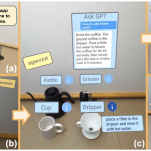
by Rahul Jain | Dec 1, 2024 | 2024, Asim Unmesh, Karthik Ramani, Karthik Ramani, Rahul Jain, Recent Publications, Subramanian Chidambaram
Computer vision (CV) algorithms require large annotated datasets that are often labor-intensive and expensive to create. We propose AnnotateXR, an extended reality (XR) workflow to collect various high-fidelity data and auto-annotate it in a single demonstration....

by Seunggeun Chi | Sep 27, 2024 | 2024, Karthik Ramani, Recent Publications, Seunggeun Chi
We study the problem of estimating the body movements of a camera wearer from egocentric videos. Current methods for ego-body pose estimation rely on temporally dense sensor data, such as IMU measurements from spatially sparse body parts like the head and hands....

by Seunggeun Chi | Sep 26, 2024 | 2024, Featured Publications, Hyunggun Chi, Karthik Ramani, Karthik Ramani, Publications, Recent Publications, Seunggeun Chi
We introduce the Multi-Motion Discrete Diffusion Models (M2D2M), a novel approach for human motion generation from textual descriptions of multiple actions, utilizing the strengths of discrete diffusion models. This approach adeptly addresses the challenge of...

by Seunggeun Chi | Sep 18, 2024 | 2024, Hyunggun Chi, Karthik Ramani, Publications, Recent Publications, Seunggeun Chi
Skeleton-based action recognition has made significant advancements recently, with models like InfoGCN showcasing remarkable accuracy. However, these models exhibit a key limitation: they necessitate complete action observation prior to classification, which...

by Dizhi Ma | Sep 16, 2024 | 2024, Dizhi Ma, Featured Publications, Jingyu Shi, Karthik Ramani, Karthik Ramani, Rahul Jain, Recent Publications, Xiyun Hu, Zhengzhe Zhu, Ziyi Liu
Table tennis stroke training is a critical aspect of player development. We designed a new augmented reality (AR) system, avaTTAR, for table tennis stroke training. The system provides both “on-body” (first-person view) and “detached”...

by Ziyi Liu | May 11, 2024 | 2024, Featured Publications, Karthik Ramani, Karthik Ramani, Publications, Recent Publications, Xiyun Hu, Zhengzhe Zhu, Ziyi Liu
Peer influence plays a crucial role in promoting classroom participation, where behaviors from active students can contribute to a collective classroom learning experience. However, the presence of these active students depends on several conditions and is not...










